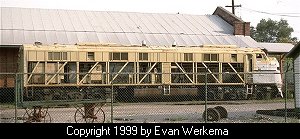 |
The term "cowl unit" describes a locomotive with a full-width carbody where the body
itself is not load-bearing. It is used to differentiate these later locomotives from
the earlier "cab" or "carbody units" such as the EMD F-units shown at left. Carbody-type
locomotives were built by most of the major diesel builders between the late 1930's
and the 1950's. They included such locomotives as EMD E- and F-units and Alco PA's and
FA's.
|
|
 | On a carbody
unit, the underframe is of relatively light construction, and is reinforced by truss-like
bracework in the sides of the locomotive. The former New York Central E-unit at left
has had its side panels removed, revealing the bracework beneath. The locomotive carbody,
then, provides structural strength in addition to being an attractive cover over the
machinery. With the body removed, the frame alone cannot support the weight of the
prime mover. |
|
 |
On a cowl unit, such as the EMD FP45 at left, a heavier underframe carries the whole
weight of the locomotive. The body of a cowl unit extends the full width of the frame
as on a carbody unit, but it is merely a protective and decorative cover.
Cowl units were built by EMD and GE starting in the late 60's. Santa Fe eventually
owned four types of cowl units: three built by EMD, and one by GE. |


